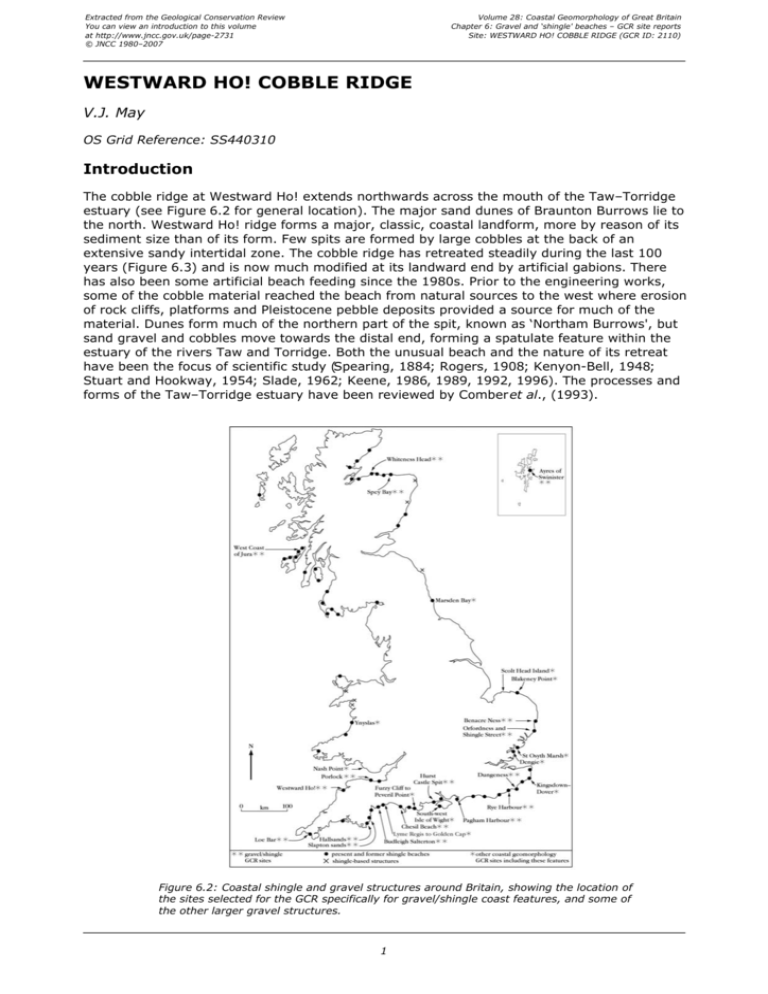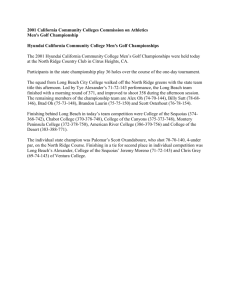westward ho! cobble ridge
advertisement

Extracted from the Geological Conservation Review You can view an introduction to this volume at http://www.jncc.gov.uk/page-2731 © JNCC 1980–2007 Volume 28: Coastal Geomorphology of Great Britain Chapter 6: Gravel and ‘shingle' beaches – GCR site reports Site: WESTWARD HO! COBBLE RIDGE (GCR ID: 2110) WESTWARD HO! COBBLE RIDGE V.J. May OS Grid Reference: SS440310 Introduction The cobble ridge at Westward Ho! extends northwards across the mouth of the Taw–Torridge estuary (see Figure 6.2 for general location). The major sand dunes of Braunton Burrows lie to the north. Westward Ho! ridge forms a major, classic, coastal landform, more by reason of its sediment size than of its form. Few spits are formed by large cobbles at the back of an extensive sandy intertidal zone. The cobble ridge has retreated steadily during the last 100 years (Figure 6.3) and is now much modified at its landward end by artificial gabions. There has also been some artificial beach feeding since the 1980s. Prior to the engineering works, some of the cobble material reached the beach from natural sources to the west where erosion of rock cliffs, platforms and Pleistocene pebble deposits provided a source for much of the material. Dunes form much of the northern part of the spit, known as ‘Northam Burrows', but sand gravel and cobbles move towards the distal end, forming a spatulate feature within the estuary of the rivers Taw and Torridge. Both the unusual beach and the nature of its retreat have been the focus of scientific study (Spearing, 1884; Rogers, 1908; Kenyon-Bell, 1948; Stuart and Hookway, 1954; Slade, 1962; Keene, 1986, 1989, 1992, 1996). The processes and forms of the Taw–Torridge estuary have been reviewed by Comber et al., (1993). Figure 6.2: Coastal shingle and gravel structures around Britain, showing the location of the sites selected for the GCR specifically for gravel/shingle coast features, and some of the other larger gravel structures. 1 Extracted from the Geological Conservation Review You can view an introduction to this volume at http://www.jncc.gov.uk/page-2731 © JNCC 1980–2007 Volume 28: Coastal Geomorphology of Great Britain Chapter 6: Gravel and ‘shingle' beaches – GCR site reports Site: WESTWARD HO! COBBLE RIDGE (GCR ID: 2110) Figure 6.3: Historical recession of position of beach crests at Westward Ho! (Based on Campbell and Bowen, 1989 and Keene, 1996.) Description The ridge described by the early writers extended from the cliffs at Westward Ho! itself to its distal end, but retreat of the spit and the threat that this posed to the village led to coast protection works (Keene, 1986, 1996) which have transformed the southern proximal part of the cobble ridge into an artificial structure. This section has been excluded from the GCR site boundary. Nevertheless, the four main elements of the original feature are still represented within the site (see Figure 7.10 for local geomorphology): Figure 7.10: Braunton Burrows and Westward Ho! GCR sites, showing locations of emerged beaches and generalized geomorphology. See also Figure 7.11 for photograph of the area around Crow Point. 2 Extracted from the Geological Conservation Review You can view an introduction to this volume at http://www.jncc.gov.uk/page-2731 © JNCC 1980–2007 Volume 28: Coastal Geomorphology of Great Britain Chapter 6: Gravel and ‘shingle' beaches – GCR site reports Site: WESTWARD HO! COBBLE RIDGE (GCR ID: 2110) 1. A single ridge of cobbles about 25 m wide, WNW-facing, which is transgressing onto blown sand overlying blue clay. The transgressional beach rests on this base at about high-water springs, but cobbles form a frontal slope to just above high-water neaps (Figure6.3). Historically, this ridge has been associated with shoreline erosion at its landward end. 2. An area of former cobble ridges that lie at an acute angle to the present-day shoreline and represent earlier phases in its growth. They underlie much of the blown sand of Northam Burrows. 3. A spatulate distal end, known as ‘Grey Sand Hill', which extends into the Taw–Torridge estuary. 4. A wide intertidal area that includes areas of sand and cobbles, particularly towards the estuary. The tidal range at spring tides is 7.9 m. The maximum is from the Atlantic Ocean, but most waves approach the beach from slightly north of west, towards which the main ridge is aligned. Interpretation The origin of the ridge is not known, although Keene (1996) regards it as a comparatively recent feature. Hall (1879) described a peat and blue clay deposit about 400 m seawards of the cobble ridge and Rogers (1908) recorded remnants of former forest, a kitchen midden and a submerged pebble ridge in the intertidal area. The peat contained leaves, seeds and fruits of iris, oak Quercus, hazel Corylus, alder Alnus, elder Sambucus, sea aster Aster tripolium, common orache Atriplex patula, blackberry Rubus, dogwood Cornus and lesser spearwort Ranunculus flammula. Shells of oyster Ostrea and limpets Patella were also recorded. The blue clays were reported to include flint flakes (thought to be Neolithic in age), small pebbles and angular fragments of Carboniferous rocks. The mud-snail Hydrobia ulvae was common and bones were said to include red deer Cervus elephas, and Celtic shorthorn cattle Bos longifrons. Since most of the sediment disappeared before modern interpretation and dating techniques were available, the records have to be taken as a possible indication that the cobble ridge lay seawards of the position of the submerged forest and that the land behind it was well colonized by vegetation. The similarity with the development of the cobble ridges at Clarach and Ynyslas on the Welsh coast (see Figure 8.15) may indicate a much earlier age (about 4000 years BP) for Westward Ho!. In contrast to summer depths of sand on the western beach of up to 1.2 m, erosion during the winter of 1983–1984 exposed a thick band of head, suggesting that a wide apron of periglacial debris may have extended some distance seawards of the present-day shoreline (Keene, 1996) and this may provide an alternative explanation for the location of the submerged forest. Erosion of such deposits would provide the source for a transgressing postglacial beach. Samples from the top of the peat bed were radiocarbon dated to 6585 ± 120 year BP (Q-672; Churchill and Wymer, 1985) and 4995 ± 105 years BP (Kidson, 1977). The Holocene sequence is described in detail by Campbell (1998) following description of inner and outer peats by Balaam et al. (1987) which indicates that the outer peat was inundated by marine/estuarine conditions about 5200 years BP. 3 Extracted from the Geological Conservation Review You can view an introduction to this volume at http://www.jncc.gov.uk/page-2731 © JNCC 1980–2007 Volume 28: Coastal Geomorphology of Great Britain Chapter 6: Gravel and ‘shingle' beaches – GCR site reports Site: WESTWARD HO! COBBLE RIDGE (GCR ID: 2110) Figure 8.15: Different interpretations of the sediment transfers at Winterton Ness. In the 1880s, according to Steers (1964a) and the Shoreline Management Plan (North Norfolk District Council et al., 1996), net sediment transport was southwards and the ness moved in the same direction. Others have suggested that transport is from the south, and Cambers (1975) and Halcrow (1988) agree on transport from both south and north with a transfer offshore and the ness extending seawards. Steers (1946a) noted that the burrows at Northam were first recorded by Ridon in 1630. Though limited, this evidence indicates a predecessor to the present feature farther seaward than the 19th century ridge. Campbell (1998) emphasizes that Westward Ho! shows clear evidence for a transition from a lower Late Devensian sea level, followed by an intially rapid rise of the Holocene sea that swamped a coastal forest dating from about 6000 years BP. With a slowing of sea level rise, the present coastal configuration was established. Stuart and Hookway (1954) cited Risdon's 17th century survey of Devon as the earliest reference to a ridge at Westward Ho!. The first useful cartographic evidence is dated 1861 when the ridge was 1.8 km long: in the following 100 years the cobble ridge migrated landwards some 152 m (Figure 6.3). The northern part of the ridge grew from four sub-ridges in 1884 to twelve in 1952. Accretion at the northern end was accompanied not only by retreat at the southern end but also a reduction in overall volume. Up to 1884, it is reported (Spearing, 1884) to have stood just over 2 m above the Burrows and about 6.5 m above the level of the sand beach. It was about 48 m wide. By 1954, it was about 25 m wide and stood a similar height above the Burrows. Steers (1964a) suggested, without quantification, that the average grain size of the sediment might also have diminished. Between 1886 and 1947 the shoreline moved seawards about 25 m at its northern bend facing the Taw–Torridge estuary, but between 1959 and 1996 the ridge crest retreated 30 m (Keene, 1996). This is thought to be the result of increasingly focused wave energy at this point. Short period waves, especially in storms from the north-west, are refracted by sand and shingle banks in the estuary. As erosion has continued unabated and coast protection measures have been undertaken, most 4 Extracted from the Geological Conservation Review You can view an introduction to this volume at http://www.jncc.gov.uk/page-2731 © JNCC 1980–2007 Volume 28: Coastal Geomorphology of Great Britain Chapter 6: Gravel and ‘shingle' beaches – GCR site reports Site: WESTWARD HO! COBBLE RIDGE (GCR ID: 2110) reports concentrate on the rate of erosion and the protection measures to be adopted (Slade, 1962; Kenyon-Bell, 1948; Stuart and Hookway, 1954; Halcrow, 1980; Comber et al., 1993). The beach and intertidal changes and sediment budget estimates have been reviewed by Comber et al., (1993), who report a net loss of shingle and cobbles on the eroding part of the ridge of 1500–5000 m3 a–1. The net annual loss between 1886 (when beach volume was estimated at 300 000 m3) and 1974 has been estimated at 1200 m3 a–1, and between 1981 and 1986 the local authority transported about 15 000 m3 a–1 of material from the distal end of the spit to re-inforce its proximal end. This has since reduced to 5000 m3 a–1 to offset erosional loss. Excepting Keene (1986), little attention is paid in the literature to the sources and origin of the cobble ridge, but there may be some similarities to the history of the Ynyslas ridge (see GCR site report in Chapter 8). There appear to have been three main natural sources for the cobbles: 1. The emerged (‘raised') beach and solifluction apron to the west of Westward Ho!, from which pebbles and cobbles have been and still are eroded and are subsequently moved by longshore transport to the modern beach. 2. offshore cobble ridges such as that described by Rogers (1908) and comparable intertidal cobble fields, from which waves would transport material landwards. 3. Materials derived directly from the erosion of the cliffs to the west. Much of the material forming the cobbles in both the emerged and modern beaches is derived from the Culm Measures. The intermittent growth of the ridge is attributed by Keene to fluctuations in the supply of pebbles from the west, depending upon both the magnitude and frequency of cliff-falls and on the rate of movement of pebbles along the shore from the west. There are some similarities between Westward Ho! and the pebble beach at Budleigh Salterton (see GCR site report in the present chapter) in that both owe their main constituents to the reworking of pebble or cobble beds. However, Budleigh Salterton has both ends and most of its length resting against the cliffs. It can only move as the cliffs retreat, a process that provides a fresh supply of pebbles to the beach. At Westward Ho!, the supply of cobbles from the emerged beach is limited. Furthermore, as the beach has migrated inland, both the distance and the area of foreshore over which the material can travel have changed. Cobbles could be moved across the intertidal area just as effectively as alongshore in the storm beach. Those within the storm beach are likely to move inland during periods of washover or to migrate alongshore towards the distal end. There is little evidence to suggest that any return towards Westward Ho! In northern Britain, many sand spits and beaches rest upon shingle and cobble ridges. At Westward Ho!, however, insufficient sand has been transported from the intertidal zone to build up the dunes on the proximal part of the spit, which rests on clay and head above a rock platform. Beaches formed of large shingle and cobbles are found at several locations along the western coasts of England and Wales (for example, the beaches at Newgale and Llanrhystyd – see Orford, 1977). There are none that form a narrow spit such as that at Westward Ho! The presence of the spit affects the alignment of the Taw–Torridge estuary and this affects the distal development of the sand beach at Braunton Burrows (see GCR site report in Chapter 7). Carter (1988) suggests that such beaches originate as a result of either marine reworking of glacial deposits by the rising Holocene sea or primary sedimentation from adjacent eroding cliffs or seabed. At Westward Ho! the latter appears to be most important, but since the source includes clasts from an emerged beach, that deposit may be attributable to either of the origins suggested by Carter. Conclusions Westward Ho! is a rare and excellent example of a narrow cobble spit. Although cobble beaches are not uncommon in Britain, they rarely occur as spits. Second, much of the material forming the spit includes clasts that were already substantially modified as a result of erosion of an emerged (‘raised') beach. Third, there is a well-documented Pleistocene–Holocene history for 5 Extracted from the Geological Conservation Review You can view an introduction to this volume at http://www.jncc.gov.uk/page-2731 © JNCC 1980–2007 Volume 28: Coastal Geomorphology of Great Britain Chapter 6: Gravel and ‘shingle' beaches – GCR site reports Site: WESTWARD HO! COBBLE RIDGE (GCR ID: 2110) the intertidal sediments. Reference list Balaam, N.D., Levitan, B. and Strater, V. [eds] (1987) Studies in Palaeoeconomy and Environment in South West England, British Archaeological Reports British Series, No.181, British Archaeological Reports, Oxford, 264 pp. Campbell, S. (1998) Westward Ho! In Quaternary of South-West England (S. Campbell, C.O. Hunt, J.D. Scourse and D.H. Keen), Geological Conservation Review Series, No.14, Joint Nature Conservation Committee, Peterborough, pp. 224–33. Carter, R.W.G. (1988) Coastal Environments: an Introduction to the Physical, Ecological and Cultural Systems of Coastlines, Academic Press, London, 617 pp. Churchill, D.M. and Wymer, J.J. (1985) The kitchen midden site at Westward Ho!, Devon, England: ecology, age and relation to changes in land and sea level. Proceedings of the Prehistoric Society, 31, 74–84. Comber, D.P.M., Hansom, J.D. and Fahy, F.M. (1993) Taw–Torridge Estuary: Coastal Processes and Conservation. Report by the Coastal Research Group, University of Glasgow for English Nature, Peterborough, 61 pp. Halcrow, Sir W. and Partners (1980) Coast Protection at the Pebble Ridge, Westward Ho!. Final report to Torridge District Council. Hall, T.M. (1879) The submerged forest of Barnstable Bay. Quarterly Journal of the Geological Society of London, 35, 106. Keene, P. (1986) Classic Landforms of the North Devon Coast, Classic Landform Guides, No.6, Geographical Association, Sheffield, 48 pp. Keene, P. (1989) Classic landforms of the North Devon Coast. Proceedings of the Ussher Society, 7 (2), 192–3. Keene, P. (1992) Coastal Management and Coastal Erosion at Westward Ho!, Thematic Trails, Oxford. Keene, P. (1996) Classic Landforms of the North Devon Coast, New edition, Classic Landform Guides, Geographical Association in conjunction with the British Geomorphological Research Group, Sheffield, 48 pp. Kenyon-Bell, C. (1948) Sea defences at Westward Ho!. Report to the Urban District Council of Northam. Kidson, C. (1977) The coast of South West England. In The Quaternary History of the Irish Sea (eds C. Kidson and M.J. Tooley), Seel House Press, Liverpool, pp. 267–98. Orford, J.D. (1977) Some aspects of beach ridge development on a fringing gravel beach, Dyfed, west Wales. In Les Côtes Atlantiques de l'Europe: Évolution, Aménagement, Protection (ed. A. Guilcher), Actes de Colloques, No. 9, Centre National pour l'Exploitation des Océans, Brest, pp. 35–44. Rogers, I. (1908) On the submerged forest at Westward Ho!. Report and Transactions of the Devon Association for the Advancement of Science, Literature and Art,40, 249–59. Slade, G.O. (1962) Westward Ho! pebble ridge. The Surveyor and Municipal and County Engineer, 23 (June), 812–14. Spearing, H.G. (1884) On the recent encroachment of the sea at Westward Ho!, north Devon. Quarterly Journal of the Geological Society of London, 40, 474. Steers, J.A. (1946a) The Coastline of England and Wales, Cambridge University Press, Cambridge, 644 pp. Steers, J.A. (1964a) The Coastline of England and Wales, 2nd edn, Cambridge University Press, Cambridge, 762 pp. Stuart, A. and Hookway, R.J.S. (1954) Coastal Erosion at Westward Ho!. Report to the Coast Protection Committee (Special), Devon County Council, 13 pp. 6 J S Publications - creating expert information resources - http://www.jspubs.com/xp







